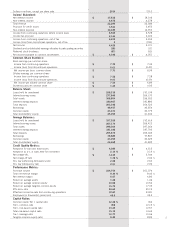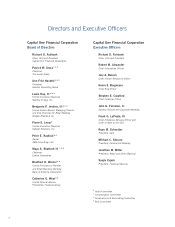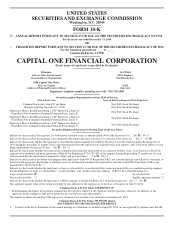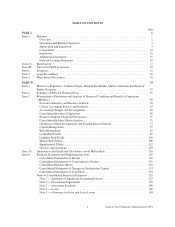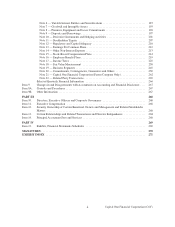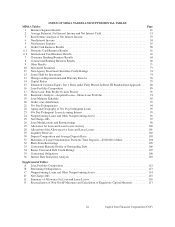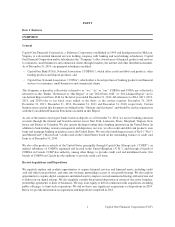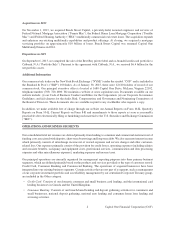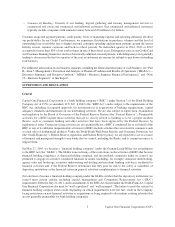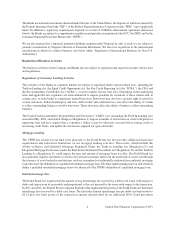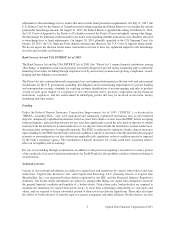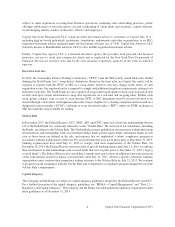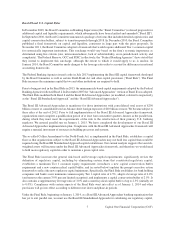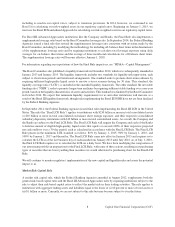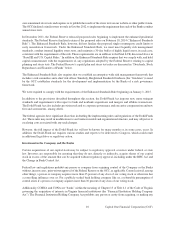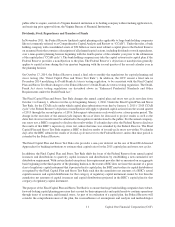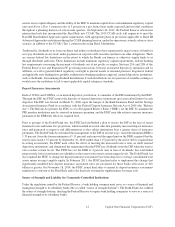Capital One 2014 Annual Report Download - page 25
Download and view the complete annual report
Please find page 25 of the 2014 Capital One annual report below. You can navigate through the pages in the report by either clicking on the pages listed below, or by using the keyword search tool below to find specific information within the annual report.
•Commercial Banking: Consists of our lending, deposit gathering and treasury management services to
commercial real estate and commercial and industrial customers. Our commercial and industrial customers
typically include companies with annual revenues between $10 million to $1 billion.
Customer usage and payment patterns, credit quality, levels of marketing expense and operating efficiency all affect
our profitability. In our Credit Card business, we experience fluctuations in purchase volumes and the level of
outstanding loan receivables due to higher seasonal consumer spending and payment patterns around the winter
holiday season, summer vacations and back-to-school periods. No individual quarter in 2014, 2013 or 2012
accounted for more than 30% of our total revenues in any of these fiscal years. Delinquency rates in our Credit Card
and Consumer Banking businesses also have historically exhibited seasonal patterns, with delinquency rates generally
tending to decrease in the first two quarters of the year as customers use income tax refunds to pay down outstanding
loan balances.
For additional information on our business segments, including the financial performance of each business, see “Part
II—Item 7. Management’s Discussion and Analysis of Financial Condition and Results of Operations (“MD&A”)—
Executive Summary and Business Outlook,” “MD&A—Business Segment Financial Performance” and “Note
19—Business Segments” of this Report.
SUPERVISION AND REGULATION
General
Capital One Financial Corporation is a bank holding company (“BHC”) under Section 3 of the Bank Holding
Company Act of 1956, as amended (12 U.S.C. § 1842) (the “BHC Act”) and is subject to the requirements of the
BHC Act, including its required approvals for investments in or acquisitions of banking organizations, capital
adequacy standards and limitations on our nonbanking activities. We are also subject to supervision, examination
and regulation by the Board of Governors of the Federal Reserve System (the “Federal Reserve”). Permissible
activities for a BHC include those activities that are so closely related to banking as to be a proper incident
thereto, such as consumer lending and other activities that have been approved by the Federal Reserve by
regulation or order. Certain servicing activities are also permissible for a BHC if conducted for or on behalf of the
BHC or any of its affiliates. Impermissible activities for BHCs include activities that are related to commerce such
as retail sales of nonfinancial products. Under the Dodd-Frank Wall Street Reform and Consumer Protection Act
(the “Dodd-Frank Act”), Federal Reserve regulation, and Federal Reserve policy, we are expected to act as a source
of financial and managerial strength to any banks that we control, including the Banks, and to commit resources to
support them.
On May 27, 2005, we became a “financial holding company” under the Gramm-Leach-Bliley Act amendments
to the BHC Act (the “GLBA”). The GLBA removed many of the restrictions on the activities of BHCs that become
financial holding companies. A financial holding company, and the nonbank companies under its control, are
permitted to engage in activities considered financial in nature (including, for example, insurance underwriting,
agency sales and brokerage, securities underwriting and dealing and merchant banking activities), incidental to
financial activities and, if the Federal Reserve determines that they pose no risk to the safety or soundness of
depository institutions or the financial system in general, activities complementary to financial activities.
Our election to become a financial holding company under the GLBA certifies that the depository institutions we
control meet certain criteria, including capital, management and Community Reinvestment Act (“CRA”)
requirements. Effective July 21, 2011, under amendments to the BHC Act enacted under the Dodd-Frank Act, Capital
One Financial Corporation also must be “well capitalized” and “well managed.” The failure to meet the criteria for
financial holding company status could, depending on which requirements were not met, result in the Company
facing restrictions on new financial activities or acquisitions or being required to discontinue existing activities that
are not generally permissible for bank holding companies.
3Capital One Financial Corporation (COF)




